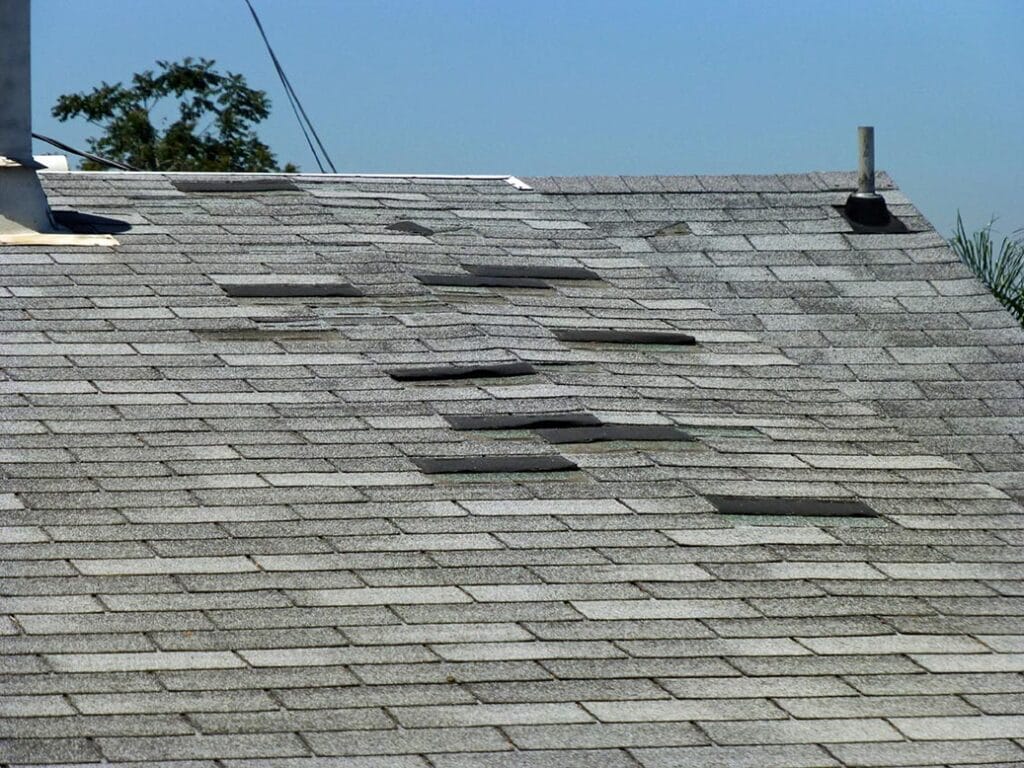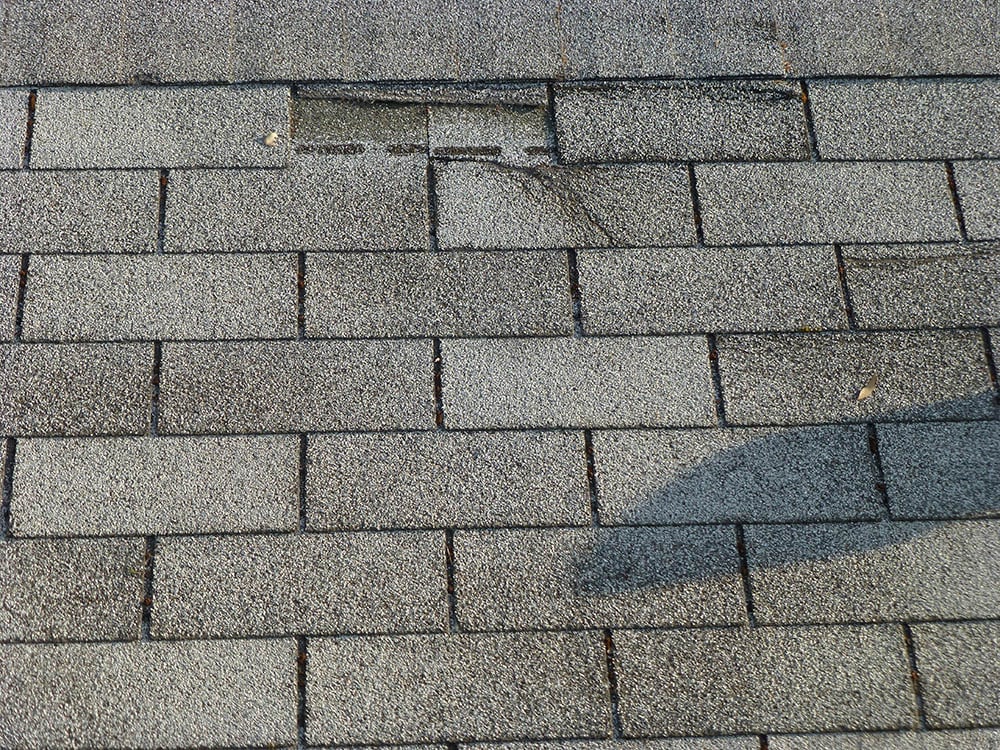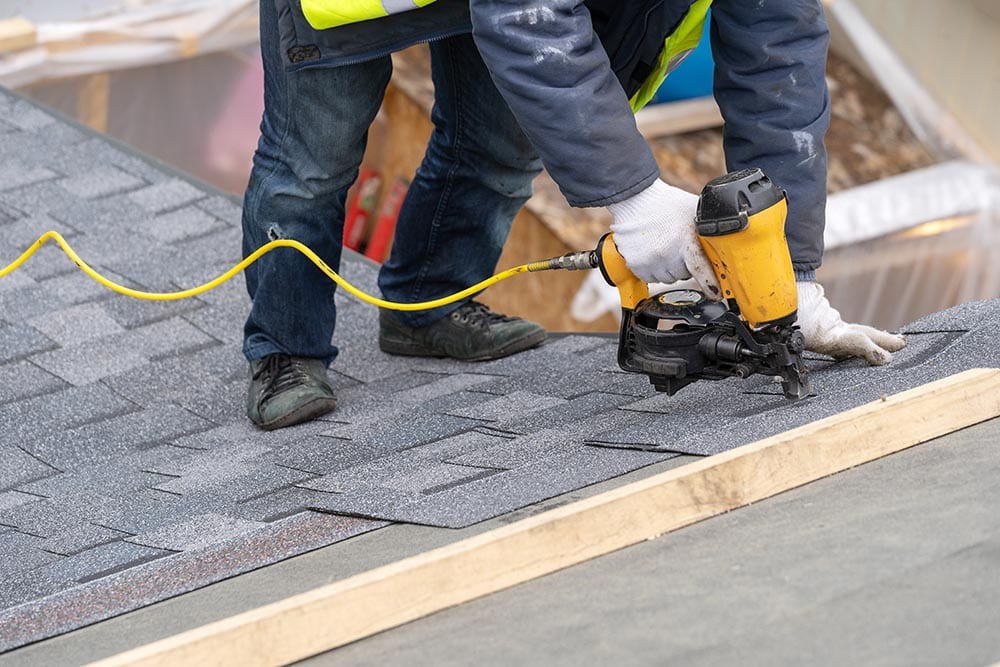What Is a Composition Roof? Pros, Cons & Types
-

- Last updated:

Even if you aren’t familiar with the term, you’ve certainly seen several composition roofs in your time. These roofs consist of asphalt shingles and are popular among homeowners for their cost-effectiveness.
There are several reasons why composite roofs are the best choice for many homes. But they also have drawbacks and limitations that make them impractical in some contexts. If you’re mulling over the many options for your new roof, we’ll define a composition roof and detail its benefits, downsides, and best uses.

How Does It Work?
A composition roof consists of several asphalt shingles in overlapping rows. We call them “composition” roofs because of the various layers in a shingle. From bottom to top, these include fiberglass or organic mat backing, asphalt, fiberglass, and protective granules. The protective granules are a mixture of crushed stones, ceramic, or minerals.
The layers work together to make the shingles fire-resistant, water-proof, and durable under the elements. Some shingles include unique treatments and additions to the granules for better durability. For instance, you can find some shingles with solar reflective treatments that limit UV damage. Meanwhile, others with copper treatments help prevent algae and moss growth.

What are the Different Types of Composition Roofs?
Composition roofs are versatile. You can find a broad spectrum of shingle colors, and many designs can mimic the look of other shingle styles, such as wood shake or slate. Though countless shingle varieties exist in different shapes, colors, sizes, and price points, there are three general categories for composition roofs: 3-tab shingles, dimensional shingles, and architectural shingles.
3-Tab Shingles
The most basic composition shingles are the 3-tab variety. These shingles lie flat on the roof, creating a simple brickwork pattern. Each shingle has two notches to create three rectangular tabs, thus the name.
If you want the cheapest composition roof, 3-tab shingles are the best option at roughly $1 per square foot. The thin profile and light weight make them easy to maintain and install. They also make them less durable, so you can expect to swap them out sooner than a higher-end type of shingle. Still, most manufacturers provide warranties ranging from 20–30 years.
Dimensional and Luxury Shingles
Shingle categories beyond the standard 3-tab variety can get blurry. It can become confusing when you hear about dimensional and luxury shingles.
Dimensional shingles have stacked layers that add depth, shadows, and a simulated wood-shake look. Luxury shingles are wider, thicker, and heavier upgrades to dimensional shingles, often creating a slate-like look.
“Luxury” and “dimensional” shingles can be confusing, abstract concepts. To make life easier, consider composition roofs in two styles — 3-tab and everything else.
The “everything else” category includes dimensional shingles that fall in a spectrum of “good, better, best”. These shingles are heavier and more durable than 3-tab varieties. They will often have better warranties of 25–50 years or even lifetime guarantees. Many also come with enhanced treatments to improve their UV and algae resistance.
The most inexpensive dimensional shingles have a repeating pattern that gives them a simple shake look. Some of these options are as cheap as 3-tab shingles. Meanwhile, you’ll find architectural shingles at the high end with complex patterns and design elements that add a luxury appeal to the home. The most expensive shingles are more than twice the cost of 3-tab shingles. They may also need a custom installation, which will bump the price up further.

Where Are Composition Roofs Used?
Due to their low cost, versatile looks, and decent durability, composition roofs are one of the most popular residential roof types in the country. Despite their general usage, there are specific circumstances when a composition roof is not the best idea. For instance, they aren’t the most resistant to the elements, so people in areas with high winds and extreme weather may want to upgrade to a metal roof.
Composition roofs need a slope as well. You can use shingles on a roof as long as it has at least a 2:12 pitch, where it rises 2 inches for every 12 inches of horizontal length. Anything shallower than that will need a rolled-on roof or another option that can handle potential water pooling.
Advantages of Composition Roofs
Composition roofs are some of the most cost-effective roofs you can install. Asphalt shingles are the cheapest roofing option available, but they’re also easy to maintain. Although they need annual maintenance, they’re less likely to have moss and algae problems than more expensive wood shakes. And with the enormous array of colors, shapes, and styles, it’s easy to customize the look to match your house.
Composition roof shingles are also easy to install and replace. Because they’re made of individual sections, one person can install them without issues. And if your roof has a damaged spot, you can fix shingles one at a time instead of lifting large sections.

Disadvantages of Composition Roofs
The primary disadvantage of composition roofs pertains to their longevity and durability. To be fair, a typical composition roof will last for roughly 20 years. With exceptional maintenance, you may be able to double or even triple that lifespan. For what composition roofs cost compared to other materials, they’re an excellent value.
Unfortunately, these roofs can also degrade over time or even fail in a heartbeat because they aren’t as resilient as many other roofing options. For instance, hard impacts from falling trees and extreme temperature changes can crack the shingles.
The granules on asphalt shingles are fragile, and their breakdown is a common reason to replace your composition roof. Walking on your roof can dislodge them, while abrasion from wind and precipitation slowly wear them down. As shingles shed granules, they lose crucial protection from UV damage, and they can become brittle and warp. When you see faded, smooth shingles or a buildup of granules in the gutter, it’s a sign that you need to replace your roof.

FAQ: Composition Roofs
How Do You Maintain a Composition Roof?
Maintaining a composition roof involves several protective measures and cleaning approaches. To prevent damage from overhanging branches, trim back any trees or plants that may pose a potential threat. You may also want to install copper strips or apply treatments that provide algae and moss protection whenever it rains.
You should keep your roof clear of debris and clean your gutters at least once every year. Using a leaf blower is an easy way to get leaves and sticks off the roof without damaging the delicate granules. Cleaning your gutters is crucial to prevent water from overflowing and lapping under your composition roof tiles, which can hasten wear and tear.
Every 2-3 years, you should wash your roof to keep algae and moss at bay. If allowed to flourish, they can wear down the granules or displace roofing shingles and open leaks. The dark streaks and green growths on your shingles also don’t help your home’s curb appeal.
- Use a spray attachment on a garden hose to spray a 1:1 chlorine and water mixture on your roof
- Do not pressure wash your roof, as it can loosen shingles
- Cover your landscaping to protect it from the falling cleaning solution, and rinse your plants with water after the project is complete
- Clean your roof on an overcast day to prevent the cleaner from evaporating too soon
It takes time for the solution to take effect. As the cleaner kills the moss or algae, rain and wind will sweep it away. Check back your roof in a couple of weeks to see if you need to clean it again.
- See also: How Long Does a Roof Last in Florida?
Are Composite and Composition Roofs the Same Thing?
Though they sound similar, composite and composition roofs are not the same thing. A composition roof involves asphalt shingles with a base mat, asphalt layer, and protective granules. By contrast, composite shingles consist of recycled materials like rubber and look more like a wood shake or slate roof.
Composite shingles, also called synthetic shingles, are much more expensive than asphalt options, but the downsides mostly end there. Compared to composition roofs, a roof using composite shingles will last longer and have better resistance to damage and weathering. It will also look nearly identical to authentic wood or slate without costing as much as the real thing. Plus, since they use recycled material, they’re much more eco-friendly than asphalt alternatives.
Final Thoughts
Composition roofs may sound like a foreign concept, but they’re among the most popular styles today, thanks to an ideal blend of budget-friendliness and practicality. Installing shingles is a low-stress way to get a roof you’ll love that will survive for several decades. Several higher-end materials will provide premium performance and longer-lasting looks. But you’ll be sure to find the perfect composition roof to match your personality and style as you peruse the nearly endless array of asphalt shingle options.
You may also be interested in: What is a Mansard Roof? What You Need To Know!
Featured Image Credit: Tujunga Photo, Shutterstock
Contents

